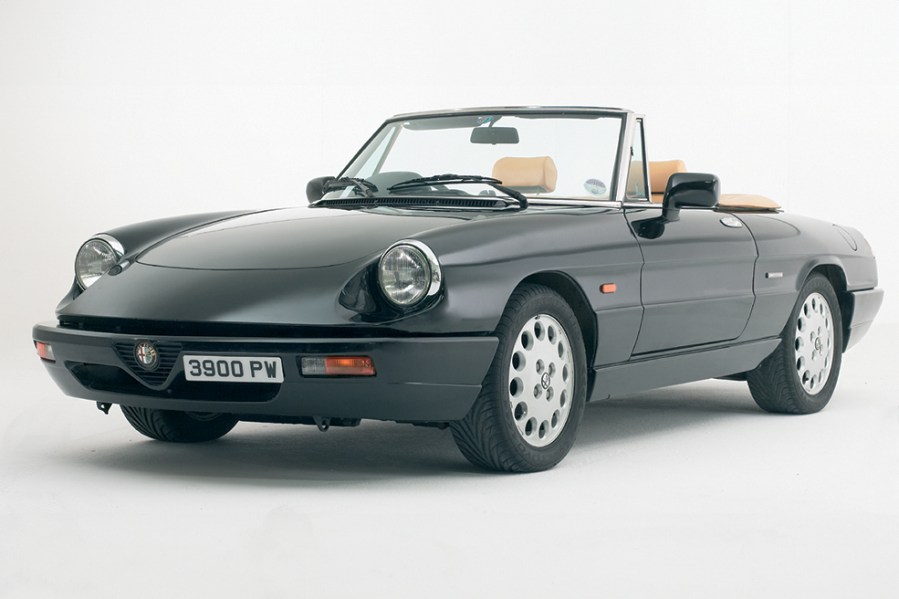The later examples of the classic Alfa Spider offer classic Italian charm with an added dose of everyday practicality. Here’s how to buy one
Images: Paull Wager, Matt Woods
Whatever your opinion of Italian cars in general, it’s hard not to like Alfa Romeo’s Spider. Its delicate Pininfarina lines and eager twin-cam motor give it an exotic edge over our home-grown roadsters and when your budget doesn’t quite stretch to a Ferrari then you can always dream if you squint hard enough.
Time was when the Spider could be had for absolute peanuts but values of even the less popular models have risen lately as the truly tatty – for which, read terminally rotten – examples have dropped off the bottom of the market. There’s still a big spread of values in the market though, with the early round-tailed Duetto models commanding values which are on a different plane from the ’80s cars.
The Spider was based on Alfa’s long-serving ‘105’ platform for its entire life and the metalwork may have remained almost unchanged from 1970 to the end but all Spiders are most definitely not the same.
Ironically, although the earlier cars are the most prized, it’s the later cars which are actually the more practical proposition and in its swansong ‘Series 4’ incarnation the Spider boasted electric windows and Bosch fuel injection as it held its corner against the upstart Mazda MX-5.
With their well-fitting hood and instant starting thanks to the German injection, these cars are as easy to live with as a Golf GTI and under the skin are as DIY-friendly as an MGB. All of which makes the cheaper end of the Spider market a more sensible place than you might. Just as long as that Pininfarina body is more metal than filler…
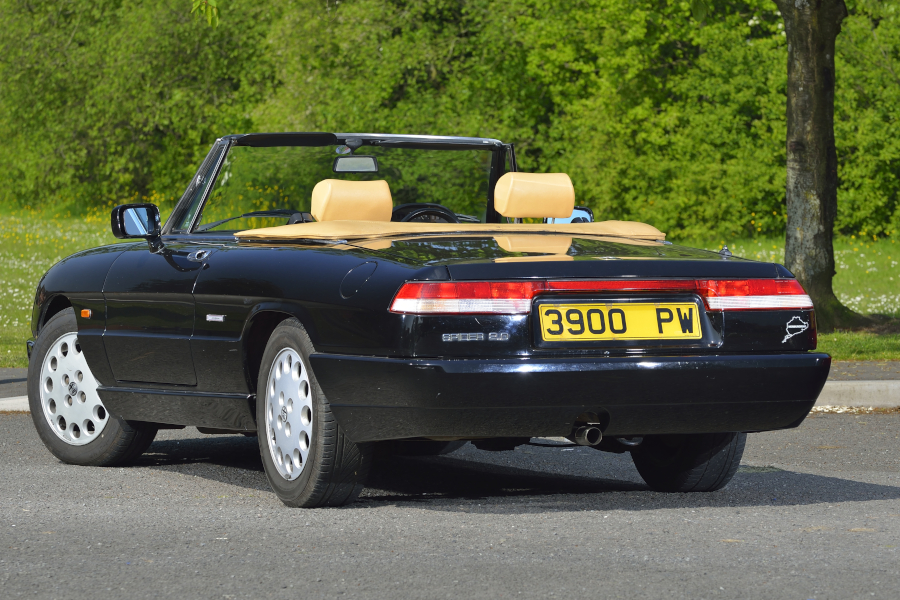
The Spider first saw the light of day in 1966 as the Duetto, the name famously being chosen in a public competition. The last design in which Pininfarina founder Battista ‘Pinin’ Farina was directly involved, the Spider was based on the florpan of the 105-series saloons of the time which included the Giulia and Giulietta. This meant a 1570cc twin-cam motor, coil-sprung suspension with independent front end and a full-synchro five-speed gearbox and shook up the market just like the MX-5 would do years later.
Back in the late ’60s, Alfa Romeo may have been a big seller in its native Italy but was still a niche brand for enthusiasts in many export markets, selling expensive cars to buyers who considered themselves proper car buffs. This perhaps explained why Alfa Romeo had the sheer front to price its 116mph 1600 Spider up at £1895 when the 150 mph Jaguar E-type was yours for £2068.
Despite its positive reception, the Duetto was short-lived and evolved into the 1750 Spider in 1967, with improved suspension and brakes plus a new entry-level 1300 ‘Spider Junior’ model added from 1968.
In 1970, the round-tailed style disappeared in favour of a squared-off ‘Kamm’ tail restyle which improved the rather limited boot space and in 1971 the 1962cc twin cam was installed to create a performance flagship model badged as Spider 2000. The following year the Spider Junior gained the 1600 engine.
Produced until 1982, this is the Spider of popular imagination with its E-type style headlamp cowls, delicate chrome bumpers and carburetted engine.
Much like the MGB, the 1980s weren’t kind to the Alfa Romeo Spider as US-inspired legislation saw it sprout chunky rubber bumpers, Alfa clumsily attempting to balance them with a prominent rubber rear spoiler wrapping around the rear end. The Quadrifoglio Verde range-topper went a step further, adding plastic side skirts and more spoilers, although the 2-litre did receive Bosch fuel injection in place of the twin carburettors.
In 1990, with the MX-5 on the scene and Alfa’s new ‘916’ front-drive GTV and Spider still a long way from production, Pininfarina was called in again to repair the damage and the result was the so-called ‘Series 4’ cars.
With the rubber bumpers replaced by modern integrated colour-coded plastic items and the rubber ducktail rear spoiler replaced by a neat kick in the rear boot lid, the Spider regained a cleaner style. The running gear remained essentially unchanged, but the adoption of more reliable electrics – including Bosch’s Motronic engine management system – and generally improved build quality saw the car take on a new lease of life. These later engines also used a variable camshaft timing device – a kind of VTEC – on the inlet camshaft to provide improved power and torque.
Air conditioning, catalytic converters and airbags were on the menu, while in a clear bow to the US market the car could even be ordered with an automatic transmission. It was an old-school three-speed unit and murdered the car’s performance but allowed the car to remain relevant in the marketplace.
The last factory right-hand drive cars had been made in 1978, since which time the Spider had been offered in the UK only to special order as a left-hooker, although various right-hand drive conversions were offered by the UK importers (via its subsidiary Seaking) and prominent Alfa dealer Bell & Colvill.
The end finally came for the 105 Spider in 1994, with the new front-drive Spider appearing the following year. The Spider had lasted an incredible 28 years and some 124,000 examples were produced in its lifetime.

Bodywork
It was made of steel in Italy a long time ago, which are all individual red flags but when combined spell a real need for caution. There’s pretty much no single area which can’t rust, but they do vary significantly and you can just as easily stumble across a surprisingly solid example as a basket case.
As usual, it’s the lower half of the bodyshell which suffers most, with the front crossmember under the radiator, the ‘chassis’ legs extending backwards from the engine bay, the floors and the sills all vulnerable. The sills are crucial for the Alfa Romeo Spider’s rigidity but on the Series 4 cars the plastic covers make it hard to judge their condition. Drive a few examples to get a feel for how much scuttle shake is to be expected and if you feel it’s excessive then suspect the sills aren’t as strong as they should be.
Repair doesn’t need an Alfa specialist, simply a competent restoration firm or bodyshop which will perform the necessary bracing to keep everything square while the sills are cut and repaired.
As well as the structural elements, check door bottoms, panel edges and wheelarches for unsightly corrosion, while the spare wheel well deserves a special mention: the towing eye is welded directly to its underside and the first you might know of any rot in the area is when it pulls off just when it’s needed in an emergency.
Detail parts can be harder to source for the later cars, although the plastic mirrors for the Series 4 cars which have been unavailable for some time have now been reproduced. Similarly, the plastic bumpers are tricky to source but can be found.
Don’t get tempted by US imports advertised as being rust-free – plenty of states are as damp as the UK, so make the same checks unless you can verify it’s come from California, Arizona or similar.
It is also important to assess the health of the folding roof when inspecting a prospective purchase. The Alfa Romeo Spider’s roof is a world away from the likes of the MGB and if it’s properly fitted will be flap and leak-free up to triple-digit speeds.
If it’s tatty, then aftermarket replacements are easily sourced for just under £500 and fitting can be a DIY proposition too. If the hood seems stiff in operation then assume the pivot points in the frame need lubricating – it should be possible to raise and lower it with one hand.
All Spiders feature a plastic rear window and its life can be extended by folding it carefully by hand to avoid it kinking when lowering the roof. Don’t open the roof in winter temperatures either, since you can easily split the plastic window when it’s cold and brittle.
The rubber hold-down clamps at either side are designed to stop the folded hood from bouncing up and down and they’re often broken but are cheap and easy to replace.
Don’t be fooled into paying over the odds for a car with the rare factory hardtop as owners report it often leaks more than the soft top.
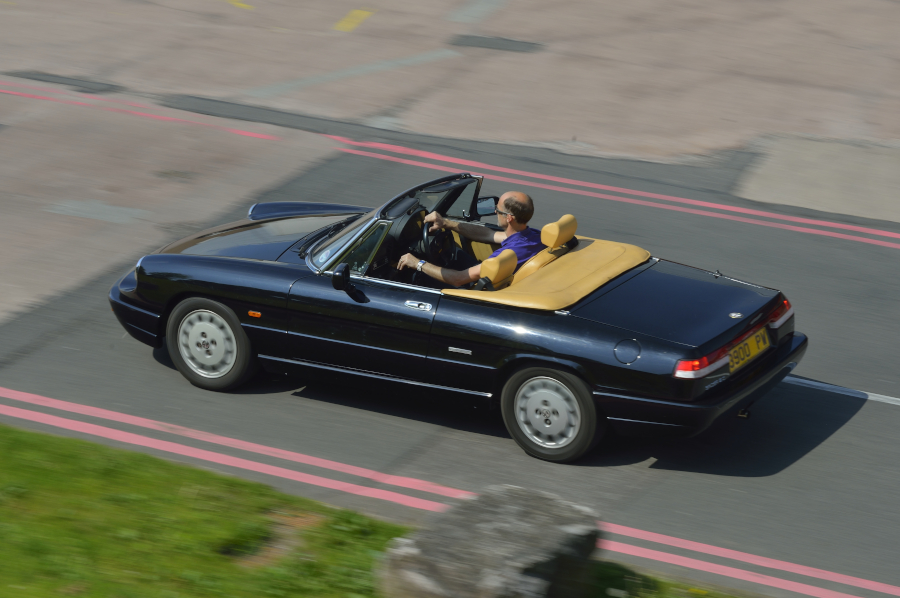
Engine and transmission
All Alfa Romeo Spider models use the familiar Alfa twin-cam, with the Series 3 and 4 cars usually found in 2.0-litre guise here in the UK. The all-alloy unit is a robust engine provided it’s properly maintained, but they do like to seep a bit of oil, the block often looking ‘sweaty’ even if there’s no obvious leak. Head gasket failure isn’t unknown, so check for signs of oil and water mixing, while the aluminium engine needs proper corrosion-inhibiting coolant rather than plain water.
Timing chains can get noisy but can be adjusted relatively easily, although the tappets are a shimmed design meaning adjustment is an involved process. The finned sump sits low and is easily damaged so peer under the car to give it a check.
If you’re looking at a European Alfa Romeo Spider, it will most likely run Bosch injection – either L-Jetronic on the Series 3 or Motronic on the Series 4. Components are shared with many other European cars of the era including BMW and Vauxhall as well as the Alfa 75/164 and are generally available.
The variable inlet cam timing on the later cars is a reliable system and failure is unusual. One easy check to make is to pull off the wire for the variator at the front of the cam cover, which should mean the engine won’t start. If it runs when the wire is reconnected then the system is operational.
Later Series 4 cars and many imported examples were fitted with a catalytic converter which does noticeably harm performance and response. A neat solution is to remove it and fit the exhaust from the earlier car, although this does mean swapping the exhaust manifolds and welding a boss into the exhaust for the oxygen sensor. The result is well worth it though, as is fitting a ‘sports’ rear section which does away with the final silencer entirely and restores that classic Alfa rasp.
On right-hand drive examples, the brake servo sits very close to the standard air box and replacing it with a cone filter and suitable cold air ducting further improves performance as well as improving accessibility.
US-market Series 2 cars used SPICA mechanical fuel injection to meet emissions requirements, but it’s hard to find the skill to set it up correctly and so most of these cars have been converted to carburettors – a shame, since when it’s running properly the high-pressure system is more efficient than the carbs.
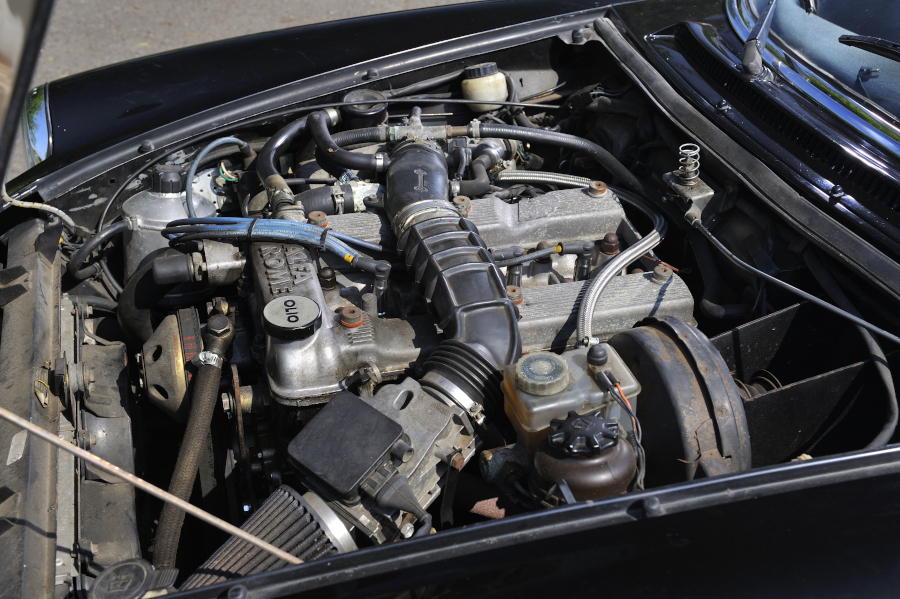
Suspension, steering and brakes
Although less archaic than an MGB, the Alfa Romeo Spider is resolutely conventional, using wishbones at the front and a leaf-sprung live axle at the rear. In fact the rear end isn’t unlike the Mk4 Cortina layout and comes with a similar trademark waddle at low speeds on broken surfaces.
Apart from ageing bushes, the suspension is pretty trouble-free, although many of the Series 4 cars seem to adopt a rear-down stance which looks terrible but is easily corrected with a pair of uprated springs.
Steering is via a box rather than a rack but is precise enough and offers the option of power assistance on the Series 4. On cars converted to right-hand drive, check the routing of the pipework from the reservoir as it can become chafed over time.
The brakes are conventional on these later cars, with a single servo and meaty twin-piston (rather than sliding single piston) calipers giving the Spider good stopping power even on RHD-converted cars which use a cross-linkage bar to operate the master cylinder on the left. Seized calipers are the major issue you’ll face but replacements are available.
The handbrake uses separate shoes inside the bell of the disc and although it’s a familiar system, the action of the lever itself never inspires confidence. It’s also worth checking that the cables are securely located rather than drooping visibly.
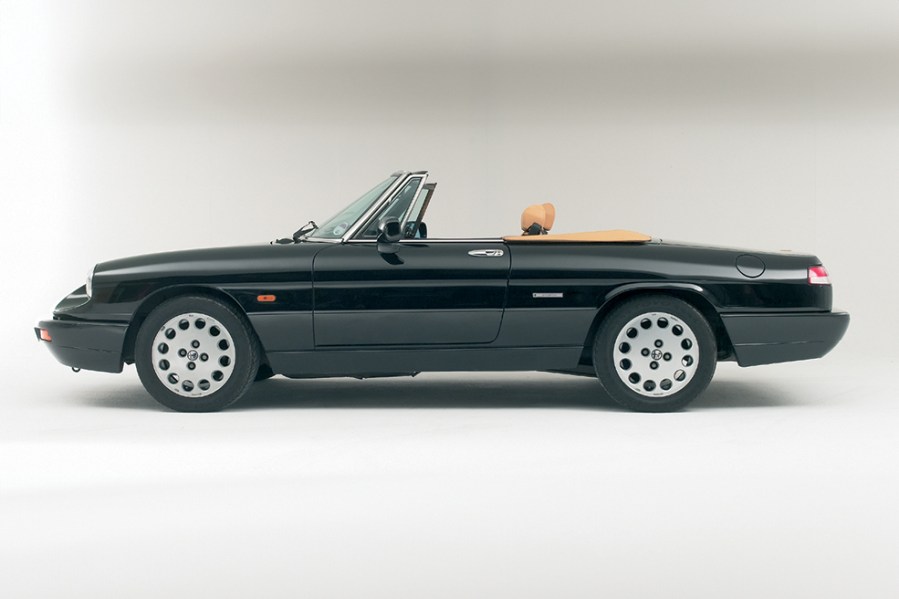
Interior, trim and electrics
A traditional Alfa failing, the trim can be fragile and much of the detail componentry and switchgear for the later cars is no longer available, especially for the Series 4. Seat covers and door cards are available, although the Alcantara used in the Series 4 cars does tend to go ‘bobbly’ very quickly in use and many owners opt for a leather retrim instead.
In general the electrics in an Alfa Romeo Spider are surprisingly reliable, belying Alfa’s reputation for electrical drama, although one or two ‘quirky’ touches still persist, including the fuel gauge which lacks any buffering in the circuitry and swings wildly when cornering.
The electric windows can become very slow, with the problem usually down to the operating cable rather than the motor. New regulators are available but it’s much cheaper to simply replace the cable… although it’s a tedious job and involves soldering new end stops in place. Note that the Series 4 regulators are unique.
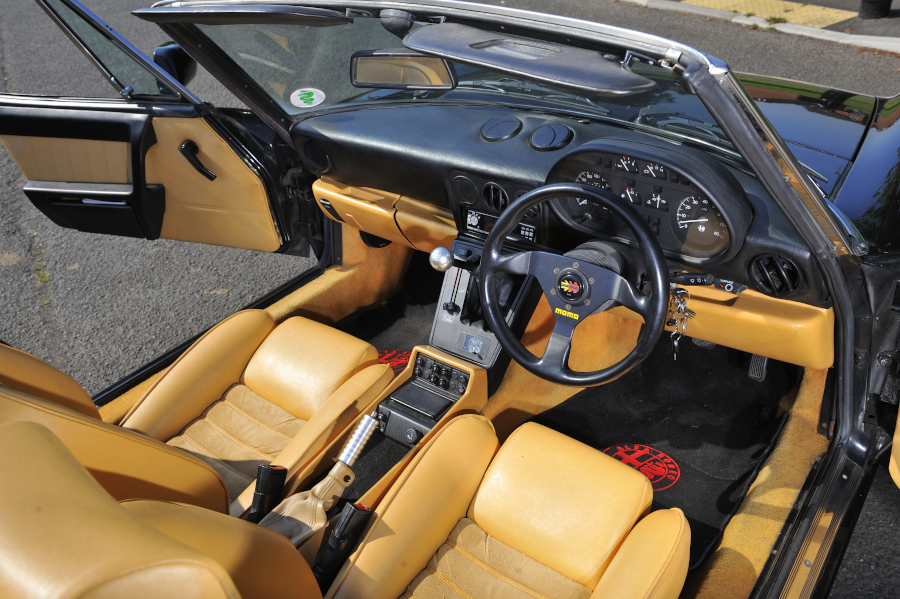
Alfa Spider S3 & S4: our verdict
I should admit to some bias here: I owned a Series 4 Alfa Romeo Spider for 23 years and in that time it proved to be the most reliable car I’ve ever owned. In fact, it left me stranded only once and that was down to a failed battery, which isn’t what you expect to hear where classic Alfas are involved.
In Series 3/4 form, the Spider combines its exotic looks with an attainable price tag and mechanical sophistication on a different level from the traditional British classics. No, it’s not the dynamic equal of the contemporary Mazda MX-5 but amazingly the average Alfa Spider these days is probably less rotten. Think of it as an affordable Ferrari with style to match an E-type and there you are.
Our preference would be for the Series 4 with its neater styling and fuss-free injection. Buy on condition, enjoy keeping it up to scratch and you won’t regret it.
Alfa Spider timeline
1966
Alfa Romeo Spider launched as the ‘boat-tailed’ Duetto using the 1600 twin cam engine
1967
1750 Spider is added
1968
Alfa Romeo Spider Junior is launched with the 1300 engine
1970
A restyle with the squared-off Kamm tail creates the Series 2
1971
Spider 2000 is created by fitting the 2-litre engine
1972
Spider Junior gains the 1600 engine
1978
Final factory right-hand drive cars are produced, after which the Spider is available in the UK only as a special order
1982
Series 3 launched with chunky bumpers, rubber spoiler and Bosch fuel injection.
1990
Series 4 is launched, restyled to lose the rubber spoiler and with plastic bumpers and sill covers
1993
Production of the classic Alfa Romeo Spider ends, with the all-new 916-generation car launched the following year.

